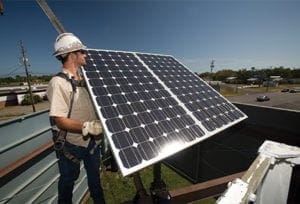
Insider is running a series on solar power and billboards. Last week Kevin Conlin, the President of Autonomous Power Solutions gave an intro to solar energy and billboards. Today he talks about grid-tied billboards. Kevin’s firm has done work for Lamar, Clear Channel Outdoor, Ralston Outdoor and Sign-Ads.
Kevin, what billboards make the best candidate for solar?
That’s a very good question, Dave, and to answer it, we have to distinguish the two types of solar billboards: Grid-Tied and Standalone.
L
A grid tied billboard is one that is connected to the power grid, but also has a solar array, usually placed on top the board to avoid theft, vandalism or shading issues. The billboard basically becomes a solar generator, feeding electricity into the grid during the day, thereby offsetting the power used at night

A grid tied billboard will work almost anywhere in the US, with the quickest payback in the Sunbelt, particularly the southwest, where they generate the most power on an annual basis.
When you combine abundant sunlight, utility incentives, state and federal tax credits, with low power LED lights; you wind up with a solar powered structure that can operate for ZERO energy costs.
To date, Lamar has deployed this strategy on a large scale, and getting back to Sean Reilly’s statement that he thought most Lamar boards would be off the grid within 10 years, it makes a lot of sense. Their structures now generate revenue from advertising and power generation.
Thinking ahead, as utilities begin time of day rate plans, the solar generated during the day will be worth several times the power used at night.
SmartLink now offers a solar option on their billboard controller that measures both the power generated and the power consumed on a daily basis.
Even states with relatively poor sunlight, such as New York and Massachusetts, offer tax incentives to make the investment attractive.
I should note that all commercial solar systems qualify for the federal 30% Investment Tax Credit (ITC) and accelerated depreciation, and most states exempt solar power systems from property taxes.
Next installment: Standalone solar power systems
Paid Ad

















